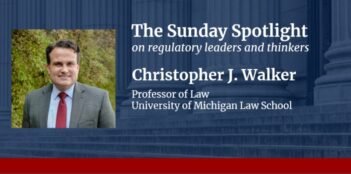
Scholars argue for legal mandates requiring regulations to do more good than harm.
Should regulations benefit society more than they hurt it? This question would seem to have an easy answer—yes, of course, regulation should deliver more good than harm. But regulators are not always required to answer that question in the course of their work.
In a recent book, Achieving Regulatory Excellence, two former White House regulatory officials argue that excellent regulators need to do better analysis to ensure that each regulation they develop helps society more than it hurts it.
Reflecting on their experiences working in the Office of Information and Regulatory Affairs (OIRA) in the Office of Management and Budget (OMB) during the Bush Administration, former OIRA Administrator John D. Graham and his former Counselor, Paul R. Noe, urge legislators to require regulators to adopt an outcome-oriented approach to regulatory excellence.
Graham and Noe argue that too many scholars and regulators focus on how regulations are made instead of on the outcomes they ultimately achieve. Although Graham and Noe agree that how regulations are made is undoubtedly important, they insist that what counts the most are regulations’ ultimate “effects on citizens, businesses, and other organizations, and the social, economic, and natural environment.”
Because of the paramount importance of the actual outcomes of regulation, Graham and Noe recommend that lawmakers put in place what they call “legally enforceable administrative substance requirements.” The requirements, they argue, would force regulators to “ensure that regulations do more good than harm.”
An administrative substance requirement would demand that regulators use regulatory impact analysis to compare the estimated benefits of regulations to their estimated costs. If the analysis shows that a regulation’s expected benefits do not exceed its expected costs, regulators should abandon the regulation.
Expecting regulators to improve society more than they hurt it may appear commonsensical. But Graham and Noe express concern that few laws in the United States and in other countries require regulators to ensure that the substance of regulations achieve net beneficial outcomes. Although recent U.S. Presidents have issued executive orders calling for administrative agencies to “justify” the costs of their proposed regulations with the benefits, these executive orders are not binding to the same extent as would be congressionally-enacted laws.
Graham and Noe worry that without legal mandates regulators may, for political reasons, sometimes reject regulations with benefits that outweigh their costs.
As an example, they point to the U.S. Environmental Protection Agency’s (EPA) 2005 Clean Air Interstate Rule, which sought to reduce harmful sulfur dioxide and nitrogen oxides emissions from coal-fired power plants. Graham and Noe explain that EPA estimated that the rule would save numerous lives each year and provide society with 30 times as many benefits as costs. Despite the compelling results of EPA’s benefit-cost analysis, President George Bush’s White House apparently refused to enact the rule. The White House resisted the rule at least in part because of the rule’s expected adverse impacts on West Virginia, a state whose economy relies primarily on the coal industry. Graham and Noe suggest that President Bush’s desire to win West Virginia’s electoral votes in his 2004 reelection bid encouraged his Administration to suppress the rule.
Graham and Noe likewise note that regulators might sometimes pursue regulations with costs that exceed their benefits. For instance, they point to President Barack Obama’s purported 2008 election pledge to support electric vehicle development in an appeal to West Coast interest groups. In delivering on his campaign promise once in office, President Obama ensured that his EPA and U.S. Department of Energy required a less cost-effective pollution control technology in cars than was otherwise available and granted waivers to ten states that exempted them from Clean Air Act requirements, Graham and Noe write. They argue that this regulatory decision cost consumers and stockholders billions of dollars and provided a much lower value of expected benefits than value of expected costs.
For Graham and Noe, examples like these demonstrate the need for a legally enforceable statute that requires regulators to do more good than harm.
They favor inserting regulatory impact analysis requirements in new laws that authorize agencies to create regulations. They specifically urge lawmakers to impose “substance” requirements that direct agencies to prioritize societal well-being over other interests. Any such substance mandate should also empower courts to strike down laws that “do more harm than good,” argue Graham and Noe.
By urging legislation that would force agencies to put society first, Graham and Noe advocate an approach to making regulation that they claim will lead regulators on a path toward excellence in a world dominated by competing interests.
Graham and Noe present their argument in a chapter in the recent book, Achieving Regulatory Excellence, edited by University of Pennsylvania Law School Professor Cary Coglianese, who serves as the director of the Penn Program on Regulation.
This essay is part of a ten-part series, entitled In Pursuit of Regulatory Excellence.



